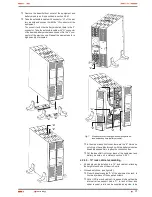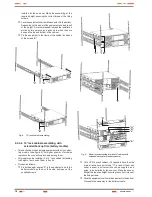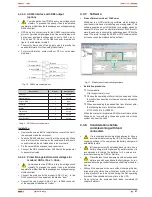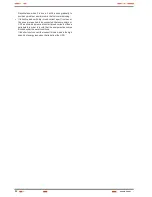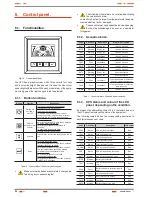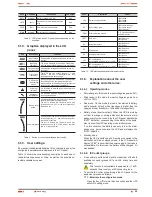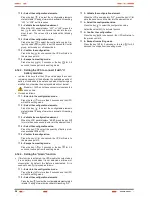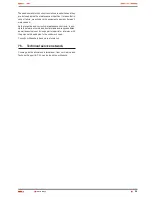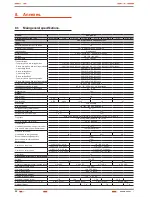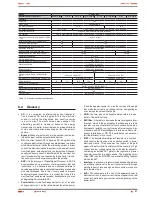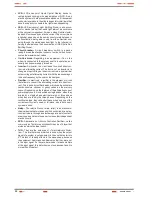
19
SALICRU
Depending on the weight of model of the equipment and
battery module, it is recommended to make the installa-
tion works by two persons.
Fix the equipment to the frame of the cabinet by means
of the screws "B".
•
Regarding the connections of the UPS with the battery
module, make the following steps, but reading section 4.3.3
previously:
Connect the supplied earth joint cable "F", between the
UPS and battery module.
Remove the beautiful front cover of the equipment and
battery module, as it is described in section 4.2.4.1.
Take the extensible cable with connector "H" of the bat-
tery module and connect it with the "G" connector of the
equipment.
To connect it with other battery modules, there is the "J"
connector. Take the extensible cable with "H" connector
of the beside battery module and connect it to the "J" con-
nector of the previous one. Repeat the same steps for a
high quantity of modules.
In the side of each front cover, there are the "K" trims as a
notch to go the cables through it with the battery modules.
Break the needed trims to pass the connection bus.
Put the beautiful front cover back of the equipment and
battery module, as it is stated in section 4.2.4.1.
4.3. Connection.
•
Cross cable section used in the power supply of the
equipment and loads to feed, will be sized according
to the nominal current stated in the nameplate sticked on the
equipment, by respecting the Low Voltage Electrotechnical
Regulations or norms of the corresponding country.
•
Installation will have the suitable input protections sized to
the current of the equipment and stated in the nameplate of
the equipment (residual current devices type B and circuit
breaker with C characteristic or any other equivalent one).
Overload conditions are considered as a nonpermanent an
exceptional operating mode, so these currents will not be
kept in mind when sizing the protections.
•
Output protection will be done with a circuit breaker of C char-
acteristic or any other equivalent one.
The equipments can be installed and used by per-
sonnel with not specific training, just with only help of
this «Manual».
•
To insert the option cards, it is needed to remove the fixing
screws of the smart slot and the own cover.
When finalising the corresponding tasks, the cover will be in-
stalled and its fixing screws again.
4.3.1. Connection of input.
•
As this is a device with class I protection against elec-
tric shocks, it is essential to install a protective earth
conductor (connect earth(
)
). Connect the conductor be-
fore connecting the power supply to the input power block.
•
Take the power cord with schuko plug and IEC connector and
connect the IEC connector to the UPS inlet. Next insert the
schuko plug to the AC mains outlet.
4.3.2. Connection of the IEC outlets.
•
As this is a device with class I protection against elec-
tric shocks, it is essential to install a protective earth
conductor (connect earth(
)
). Connect the conductor to
the terminal, before connecting the power supply to the input
power block.
•
All the equipments have female IEC outlets, in greater or lesser
numbers depending on the power rate of the equipment:
Models up to 1 kVA: 1 group of 4 IEC outlets of 10A.
Models of 1,5 and 2 kVA: 2 groups of 4 IEC outlets of 10A la-
belled as LS1 and LS2, which can be set through the control
panel and/or Win Power.
Models of 3 kVA: 2 groups of 4 IEC outlets of 10A labelled
as LS1 and LS2, which can be set through the control panel
and/or Win Power, plus a IEC connector of 16A.
Loads can be connected to the IEC outlets, mean-
while the features of the equipment and IEC out-
lets limitations are not exceeded, otherwise there will be
sudden blackouts in the power supply of the connected
loads at the output.
•
If besides of the critical loads, it is required to connect lag-
ging loads of high consumption, like laser printers or CRT
monitors, the inrush currents of these peripherals will be kept
in mind in order to avoid blocking the equipment under the
worst conditions.
It is better to not connect the loads of this kind, due to the high
quantity of energy resources that take from the UPS.
4.3.3. Connection of the external
batteries (extended back up time).
•
As this is a device with class I protection against elec-
tric shocks, it is essential to install a protective earth
conductor (connect earth(
)
). Connect the conductor to
the terminal, before connecting the power supply to the input
power block.
•
To not respect the stated indications in this sec-
tion and the safety instructions 1.2.3 means a
high risk of electrical discharge and even the death.
•
To connect the batteries with the equipment, follow the de-
scribed steps in sections 4.2.4.4 and 4.2.4.6.
•
All the standard UPSs have batteries in the same enclosure,
less the B0 and B1 (not available for models equal or below
1kVA). Battery protection is done by internal fuses and not ac-
cessible for the end-user.
Battery modules have internal protections for the batteries
too and they are not accessible for the end-user.
•
IMPORTANT FOR SAFETY: In case of installing the
batteries by yourself, the accumulators has to be pro-
vided with a two pole circuit breaker protection sized to the
features stated in table 3.
•
Before starting the connection between the bat-
tery module/s and the equipment, check that the
equipment and loads are in "Off" position.
Likewise when batteries are installed by the own user,
the fuse or switch has to be turned off.
•
Connection terminals of external batteries with the equip-
ment are done with a polarised Anderson connector. This
connector is not available in models up to 1kVA.
•
For battery connection with the equipment, follow the stated
steps in sections 4.2.4.4 and 4.2.4.6, keeping in mind the model.













